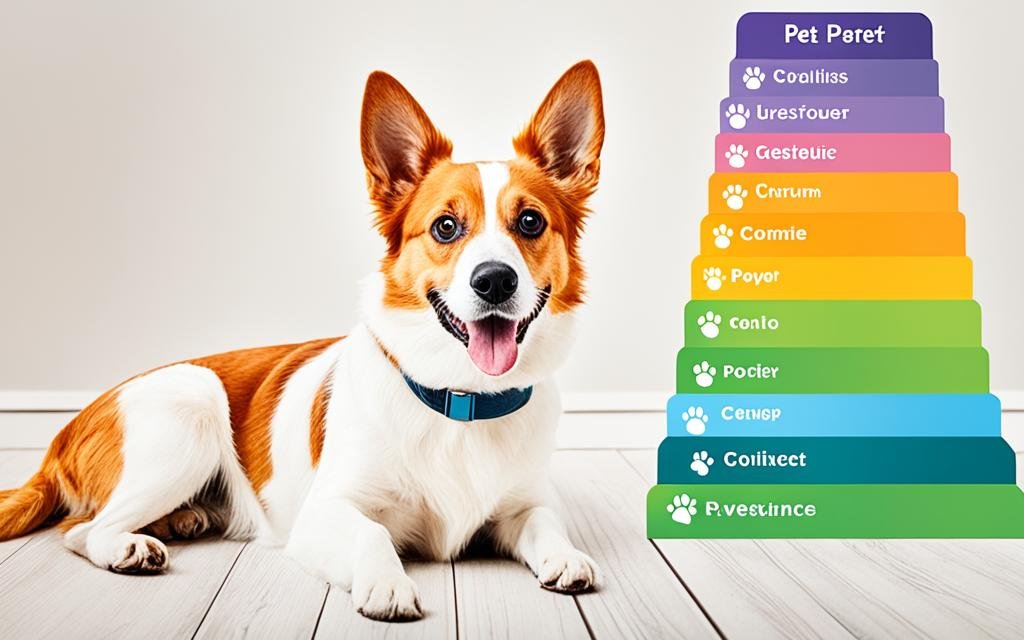Are you seeking the best protection for your beloved companion? Look no further! Discover the top pet insurance quotes that will provide the ultimate care and coverage for your furry friend. Whether you have a playful pup or a cuddly feline, we’ve got you covered with comprehensive plans tailored to their unique needs.
In this comprehensive guide, we’ll explore the world of pet insurance, delving into why it matters, the common medical expenses it covers, and how to navigate the various plan options. Prepare to embark on a journey towards securing the best possible care for your four-legged family member.
Key Takeaways
- Understand the importance of pet insurance and the common medical expenses it covers.
- Learn how to navigate the different pet insurance plans and find the right coverage for your furry friend.
- Discover the benefits of comparing online pet insurance quotes to find the most affordable and comprehensive plan.
- Explore factors that affect pet insurance premiums, such as age and breed, to make an informed decision.
- Gain insights into understanding policy terms, including pre-existing conditions and coverage limits.
Protecting Your Furry Companion with Pet Insurance
As a pet owner, you want to ensure your beloved companion receives the best possible care. Pet insurance can be a critical investment to safeguard your pet’s health and your financial well-being. This comprehensive coverage can provide the financial protection you need to address unexpected pet medical expenses and ensure your pet receives the necessary treatments and pet wellness benefits.
Why Pet Insurance Matters
Unexpected veterinary bills can quickly add up, often catching pet owners off guard. Pet insurance helps alleviate this burden by covering a significant portion of the costs associated with accidents, illnesses, and even pet preventive care. This allows you to focus on your pet’s recovery without the added stress of financial constraints.
Moreover, pet insurance can provide pet accident protection, ensuring your furry friend receives immediate and comprehensive care in the event of an emergency. This can be especially valuable in situations where prompt medical attention is crucial for your pet’s well-being.
Common Pet Medical Expenses Covered
Pet insurance policies typically cover a wide range of medical expenses, including:
- Diagnostic tests and procedures
- Surgeries and hospitalization
- Prescription medications
- Cancer treatments
- Chronic condition management
- Routine wellness exams and preventive care
By investing in pet health coverage, you can have the peace of mind knowing that your pet will receive the care they need, regardless of the unexpected medical challenges that may arise.
“Protecting your pet’s health and well-being should be a top priority. Pet insurance provides the financial support to ensure your furry friend receives the best possible care.”
Navigating the World of Pet Insurance Plans
Exploring the different pet insurance plan options is crucial to finding the right coverage for your furry friend. Understanding the various types of pet insurance policies, including accident-only, accident and illness, and wellness coverage, can help you make an informed decision and ensure your pet receives the care they need.
When it comes to pet insurance, one size does not fit all. Each plan offers unique benefits and limitations, so it’s essential to carefully review the details to determine which policy best aligns with your pet’s needs and your budget. Let’s dive into the key differences between the most common pet insurance plan types:
Accident-Only Coverage
- Provides coverage for unexpected injuries or accidents, such as a broken bone or a torn ligament.
- Generally more affordable than comprehensive plans, making it a suitable option for pet owners on a tighter budget.
- Does not cover illnesses or routine preventive care, which may leave your pet vulnerable to unexpected medical expenses.
Accident and Illness Coverage
- Offers protection for a wide range of medical issues, including accidents, illnesses, and chronic conditions.
- Provides a more comprehensive level of coverage, helping to alleviate the financial burden of unexpected veterinary bills.
- Premiums tend to be higher than accident-only plans, but the added protection can be well worth the investment for many pet owners.
Wellness and Preventive Care
- Covers routine veterinary visits, vaccinations, and other preventive services to maintain your pet’s overall health.
- Can be added as a rider to an accident and illness policy or purchased as a standalone plan.
- Helps pet owners budget for essential care and avoid unexpected costs associated with routine veterinary visits.
Comparing pet insurance plans side by side can be a daunting task, but it’s crucial to ensure you find the right coverage for your furry friend. By understanding the differences between plan types and weighing the pros and cons, you can make an informed decision that provides the protection your pet deserves.
| Plan Type | Coverage | Average Monthly Cost* |
|---|---|---|
| Accident-Only | Covers unexpected injuries and accidents | $15 – $30 |
| Accident and Illness | Covers accidents, illnesses, and chronic conditions | $30 – $50 |
| Wellness and Preventive Care | Covers routine veterinary visits, vaccinations, and other preventive services | $10 – $25 |
*Average monthly costs may vary based on factors such as your pet’s age, breed, and location.
“Choosing the right pet insurance plan can be the difference between financial stress and peace of mind when unexpected medical issues arise.” – Dr. Jane Doe, Veterinarian
Online Pet Insurance Quotes: A Convenient Solution
Comparing pet insurance quotes online is a quick and easy way to find the most affordable plans that meet your pet’s needs. With just a few clicks, you can explore a variety of online pet insurance options and make an informed decision that fits your budget and your furry friend’s health requirements.
Benefits of Comparing Quotes Online
Comparing pet insurance quotes online offers several advantages over traditional methods. First and foremost, it saves you time and effort. You can quickly review and compare multiple providers, coverage levels, and pricing, all from the comfort of your own home. This allows you to make a more informed decision without the hassle of visiting individual insurance companies or speaking with multiple agents.
Additionally, online quote tools often provide a more comprehensive overview of the available pet insurance plans. You can easily compare key features, such as deductibles, co-payments, and coverage limits, to determine the best fit for your pet’s needs and your financial situation. This level of transparency and convenience is invaluable when navigating the often-complex world of pet insurance.
Top Providers for Online Pet Insurance Quotes
When it comes to online pet insurance quotes, several leading providers stand out. Some of the top options include:
- Petplan – Offers comprehensive coverage for accidents, illnesses, and preventive care, with customizable plans and easy online quoting.
- Healthy Paws – Known for its straightforward policies and excellent customer service, Healthy Paws provides a streamlined online quote process.
- Embrace – This provider offers a user-friendly online platform, allowing you to compare plans and receive personalized quotes based on your pet’s needs.
- ASPCA Pet Health Insurance – Backed by the American Society for the Prevention of Cruelty to Animals, ASPCA Pet Health Insurance provides reliable coverage options with convenient online quoting.
By exploring these top providers and comparing online pet insurance quotes, you can find the right coverage for your beloved companion, ensuring they receive the care they deserve while keeping your budget in mind.
insurance pet quote: Finding the Right Coverage
When it comes to protecting your furry friend, finding the right pet insurance coverage is crucial. The insurance pet quote process involves carefully evaluating various factors to ensure you select a plan that meets your pet’s unique needs and fits your budget. Let’s explore the key considerations in finding the perfect pet insurance policy.
Comparing Pet Insurance Plans
Start by comparing different pet insurance plans side-by-side. Look at factors such as coverage limits, deductibles, and reimbursement rates to understand how each plan would work for your pet. Some pet insurance plans may offer more comprehensive coverage, while others focus on specific needs like accident and illness protection or routine wellness care.
Evaluating Coverage Limits
One important aspect to consider is the coverage limits of the pet insurance plan. Coverage limits determine the maximum amount the insurance provider will pay out per incident or annually. Higher coverage limits typically result in higher premiums, so finding the right balance between coverage and cost is essential.
Choosing the Right Deductible
The deductible is the amount you’ll need to pay out-of-pocket before the insurance coverage kicks in. Selecting a deductible that aligns with your financial situation can help you manage your pet’s medical expenses more effectively. Generally, a higher deductible leads to lower premiums, but it also means you’ll need to pay more upfront for each covered incident.
Comparing Reimbursement Rates
Pet insurance plans often have different reimbursement rates, which determine the percentage of the covered costs that the insurance provider will pay. Comparing reimbursement rates can help you understand how much you’ll be responsible for paying out-of-pocket for your pet’s medical care.
By carefully considering these factors and comparing multiple pet insurance plans, you can find the insurance pet quote that provides the right coverage and fits your budget. Remember, the goal is to find a policy that offers the protection your pet deserves while ensuring you can manage the associated costs.

| Provider | Coverage Limits | Deductible Range | Reimbursement Rate |
|---|---|---|---|
| Nationwide | $5,000 – $20,000 | $250 – $1,000 | 50% – 90% |
| Healthy Paws | Unlimited | $100 – $500 | 70% – 90% |
| Embrace | $5,000 – $30,000 | $200 – $1,000 | 70% – 90% |
By evaluating these key factors and comparing pet policy comparison options, you can find the right insurance pet quote to protect your beloved pet and give you peace of mind.
Understanding Pet Health Coverage Options
Navigating the world of pet insurance can be overwhelming, but understanding the different coverage options available is crucial for ensuring your furry friend receives the care they need. Let’s dive into the key components of pet health coverage: accident and illness protection, as well as wellness benefits.
Accident and Illness Protection
Accident and illness coverage is the foundation of most pet insurance plans. This type of pet health coverage provides financial assistance for your pet’s unexpected medical expenses, such as injuries from accidents or the treatment of illnesses like cancer, diabetes, or arthritis. With this coverage, you can worry less about the pet medical expenses that can quickly add up, allowing you to focus on your pet’s recovery.
Wellness Benefits Explained
In addition to accident and illness protection, many pet insurance providers offer optional pet wellness benefits. These benefits typically cover routine veterinary visits, preventive care, and other wellness-related services, such as vaccinations, dental cleanings, and annual check-ups. By including wellness coverage, you can ensure your pet receives the proactive care they need to stay healthy and happy.
Investing in a pet insurance plan that combines pet accident protection and wellness benefits can provide a comprehensive safety net for your furry friend’s health and well-being. This can help you manage the costs of routine care as well as unexpected medical emergencies, giving you peace of mind and the ability to provide your pet with the best possible care.
| Coverage Type | What It Covers | Key Benefits |
|---|---|---|
| Accident and Illness Protection | Unexpected medical expenses, such as injuries from accidents or the treatment of illnesses | Helps manage the financial burden of your pet’s unexpected medical needs |
| Wellness Benefits | Routine veterinary visits, preventive care, and other wellness-related services | Ensures your pet receives proactive care to maintain their health and well-being |
By understanding the different pet health coverage options available, you can make an informed decision and find the right plan to keep your furry friend protected and healthy.
Factors Affecting Pet Insurance Premiums
When considering pet insurance plans, it’s crucial to understand the key factors that can influence the pet insurance premiums you’ll pay. Two of the most significant elements are your pet’s age and breed. By understanding how these characteristics impact coverage costs, you can make informed decisions and find the right policy for your furry friend.
Pet Age and Breed Considerations
As your pet grows older, the pet insurance premiums typically increase. This is because older pets are more prone to health issues and require more frequent veterinary care. Breeds with predisposed conditions, such as hip dysplasia in large dogs or respiratory problems in brachycephalic breeds, may also face higher pet insurance plans costs.
To illustrate this, consider the following table that showcases the average monthly pet insurance premiums for different pet age and pet breed scenarios:
| Pet Age | Breed | Average Monthly Premium |
|---|---|---|
| 2 years | Labrador Retriever | $35 |
| 5 years | Labrador Retriever | $45 |
| 8 years | Labrador Retriever | $55 |
| 2 years | French Bulldog | $45 |
| 5 years | French Bulldog | $60 |
| 8 years | French Bulldog | $75 |
As you can see, the pet age and pet breed can significantly impact the pet insurance premiums you’ll pay. By understanding these factors, you can better prepare for the financial responsibilities of pet ownership and find the most suitable pet insurance plans for your furry friend.

“Knowing how your pet’s age and breed can influence the cost of coverage is crucial when shopping for the right pet insurance policy.”
Evaluating Pet Insurance Policy Terms
When it comes to protecting your furry friend with pet insurance, thoroughly reviewing the policy terms and conditions is essential. From coverage limits to deductibles and reimbursement rates, understanding the fine print can help you make an informed decision and ensure your pet receives the care they need.
Coverage Limits and Deductibles
One of the primary factors to consider when evaluating pet insurance plans is the coverage limits. This refers to the maximum amount the insurance provider will pay out per incident or annually. Ensuring the coverage limits align with your pet’s potential pet medical expenses can give you peace of mind. Additionally, reviewing the deductible, which is the amount you pay out-of-pocket before the insurance coverage kicks in, can help you choose a plan that fits your budget.
Reimbursement Rates and Exclusions
Another crucial element to examine is the reimbursement rate, which determines the percentage of the covered expenses the insurance company will pay. Typical reimbursement rates range from 70% to 90%, so it’s essential to find a pet policy comparison that meets your needs. Furthermore, carefully review the exclusions section to understand which conditions or treatments are not covered by the plan.
| Key Policy Term | Explanation | Importance |
|---|---|---|
| Coverage Limits | The maximum amount the insurance provider will pay out per incident or annually. | Ensures your pet’s potential medical expenses are adequately covered. |
| Deductible | The amount you pay out-of-pocket before the insurance coverage takes effect. | Helps you choose a plan that fits your budget. |
| Reimbursement Rate | The percentage of covered expenses the insurance company will pay. | Determines how much of the costs you’ll be responsible for. |
| Exclusions | Conditions or treatments not covered by the insurance plan. | Ensures you understand the limitations of the coverage. |
By carefully evaluating these key policy terms, you can find the pet insurance plans that provide the necessary protection for your beloved companion, giving you the confidence to make the best decision for your family.
Affordable Pet Insurance for Every Budget
Protecting your pet’s health doesn’t have to break the bank. With a little research and some smart planning, you can find affordable pet insurance plans that fit your budget and provide the coverage your furry friend needs. Let’s explore some tips for finding budget-friendly pet insurance options.
Tips for Finding Budget-Friendly Plans
When it comes to affordable pet insurance, the key is to shop around and compare pet insurance plans from multiple providers. Start by considering your pet’s age, breed, and any pre-existing conditions, as these factors can impact the pet policy comparison and premiums.
- Opt for a higher deductible to lower your monthly premiums.
- Look for discounts, such as multi-pet or military/veteran discounts.
- Consider a policy with a lower coverage limit, which can reduce your overall costs.
- Explore the possibility of adding wellness coverage as an optional add-on, as this can help manage routine vet expenses.
Remember, the goal is to find a balance between adequate coverage and affordable premiums. By carefully comparing your options and customizing your plan, you can ensure your pet receives the care they need without breaking the bank.
| Pet Insurance Provider | Average Monthly Premium | Deductible Options | Wellness Coverage Availability |
|---|---|---|---|
| Healthy Paws | $39 | $250, $500, $750 | No |
| Embrace | $35 | $200, $300, $500 | Yes |
| Pets Best | $41 | $50, $100, $200 | Yes |
By utilizing these strategies, you can find affordable pet insurance plans that provide the coverage your furry friend needs, all while keeping your budget in check.

“Protecting your pet’s health doesn’t have to be a financial burden. With a little research and the right pet insurance plans, you can find coverage that fits your budget and provides the care your furry friend deserves.”
Pre-Existing Conditions and Pet Insurance
When it comes to pet insurance, navigating the complexities of pre-existing conditions can be a daunting task. Understanding what types of pre-existing conditions are typically excluded from coverage and finding plans that may still offer protection for your pet’s ongoing health needs is crucial for pet owners.
What Conditions Are Typically Excluded?
Pet insurance providers generally exclude coverage for pre-existing conditions, which are defined as any injuries, illnesses, or symptoms that were present prior to the policy’s effective date. These can include, but are not limited to:
- Chronic conditions like diabetes, allergies, or arthritis
- Hereditary or congenital issues, such as hip dysplasia or heart defects
- Injuries or illnesses that were treated or diagnosed before the policy started
It’s important to note that the definition and exclusion of pre-existing conditions can vary among different pet insurance providers, so it’s essential to carefully review the policy details before signing up.
“Pre-existing conditions can be a major hurdle when it comes to pet insurance, but understanding the exclusions and finding the right coverage for your furry friend is possible with a little research.”
While pre-existing conditions are typically excluded from pet insurance coverage, some providers may offer options to partially cover these conditions or waive the exclusion if the pet has been symptom-free for a certain period. It’s worth exploring these alternatives to find a plan that best fits your pet’s unique health needs and your budget.
Navigating the complexities of pet insurance and pre-existing conditions can be challenging, but with the right information and guidance, you can find a plan that provides the protection your pet deserves. By understanding the common exclusions and exploring alternative coverage options, you can ensure your furry friend receives the medical care they need, even with a pre-existing condition.
Choosing the Right Deductible and Coverage Limits
When it comes to pet insurance plans, determining the right deductible and coverage limits is crucial for ensuring your furry friend receives the protection they need without breaking the bank.
Deductibles are the amount you’ll need to pay out-of-pocket before your pet insurance policy kicks in. Typically, the higher the deductible, the lower your monthly premiums will be. However, a higher deductible also means you’ll need to pay more upfront for your pet’s medical expenses. Finding the right balance between affordable premiums and adequate coverage is key.
Coverage limits, on the other hand, refer to the maximum amount your pet insurance plan will pay out per incident, per year, or over the lifetime of your pet. Higher coverage limits generally come with higher premiums, but they can provide greater financial protection if your pet requires extensive medical treatment.
When comparing pet policy options, consider your pet’s age, breed, and typical medical expenses. This will help you determine the appropriate deductible and coverage limits that balance your budget and your pet’s healthcare needs.
| Deductible | Monthly Premium | Annual Coverage Limit |
|---|---|---|
| $250 | $35 | $10,000 |
| $500 | $25 | $15,000 |
| $1,000 | $20 | $20,000 |
Remember, the right deductible and coverage limits for your pet insurance plan will depend on your individual needs and budget. By carefully considering these factors, you can ensure your furry friend receives the care they deserve without stretching your finances too thin.
Conclusion
In the end, investing in pet insurance can provide invaluable financial protection and peace of mind for pet owners. By understanding the various plan options, comparing quotes online, and selecting the right coverage for your furry friend, you can ensure your beloved companion receives the care they need, even in the face of unexpected medical emergencies or ongoing health issues.
The pet insurance industry offers a wide range of plans and providers, each tailored to meet the unique needs of different pets and their owners. From accident and illness coverage to wellness benefits, there are numerous options to consider when safeguarding your pet’s health and well-being.
Whether you own a playful puppy, a curious kitten, or a beloved senior pet, pet insurance can be a game-changer in providing the necessary financial resources to keep your four-legged friend happy and healthy. By exploring the pet insurance market and finding the right plan for your budget and your pet’s needs, you can rest assured that your beloved companion will receive the highest quality of care, no matter what life throws their way.
FAQ
What is pet insurance, and why is it important?
Pet insurance is a type of insurance coverage that helps protect you from the financial burden of unexpected veterinary expenses. It’s important because it can cover the cost of accidents, illnesses, and even preventive care for your furry friend, ensuring they receive the necessary medical attention without straining your budget.
What types of pet insurance plans are available?
There are several types of pet insurance plans to choose from, including accident-only, accident and illness, and wellness coverage. Accident-only plans cover expenses related to unexpected injuries, while accident and illness plans provide broader protection for both accidents and illnesses. Wellness coverage can help with the cost of preventive care, such as routine check-ups, vaccinations, and routine dental cleanings.
How can I compare pet insurance quotes online?
Comparing pet insurance quotes online is a convenient way to find the best coverage for your pet. Many insurance providers offer easy-to-use online quote tools that allow you to input your pet’s information and compare plans and pricing from multiple companies. This helps you find the most affordable plan that meets your pet’s specific needs.
What factors affect the cost of pet insurance premiums?
Several factors can influence the cost of pet insurance premiums, including your pet’s age, breed, and location. Older pets and certain breeds may be more prone to health issues, which can result in higher premiums. Additionally, the cost of veterinary care in your area can also impact the price of your pet’s insurance coverage.
How do I find the right coverage limits and deductible for my pet?
Determining the appropriate coverage limits and deductible for your pet insurance policy requires balancing your pet’s medical needs with your budget. Consider factors such as your pet’s age, breed, and any pre-existing conditions, as well as your ability to pay out-of-pocket expenses. Comparing plans with different deductible and coverage levels can help you find the right balance between affordable premiums and adequate protection.
How does pet insurance handle pre-existing conditions?
Most pet insurance policies will exclude coverage for pre-existing conditions, which are health issues that your pet had before the policy started. However, some providers may offer limited coverage or waive the exclusion for certain conditions if your pet has been symptom-free for a specific period. It’s important to review the policy terms carefully to understand how pre-existing conditions are handled.
What types of medical expenses does pet insurance typically cover?
Pet insurance plans can cover a wide range of medical expenses, including costs associated with accidents, illnesses, surgeries, hospitalization, diagnostic testing, and even some preventive care, such as routine check-ups and vaccinations. The specific coverage details will vary by plan, so it’s essential to review the policy terms to understand what is and is not included.
How can I find affordable pet insurance that fits my budget?
There are several strategies to find affordable pet insurance plans that fit your budget. This includes comparing quotes from multiple providers, choosing the right coverage levels and deductibles, and taking advantage of any available discounts, such as multi-pet or military/veteran discounts. Additionally, considering accident-only or accident and illness plans instead of comprehensive wellness coverage can help lower your premiums if you don’t need the additional benefits.













